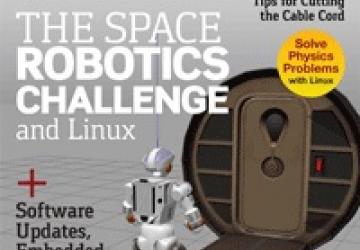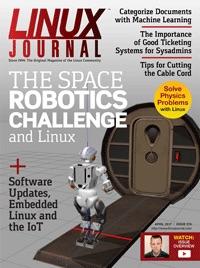Linux Journal April 2017


If There Was a Problem? Yo, I'll Solve It...
I'm not sure what problem Vanilla Ice solved with his DJ's sick hook, but thankfully in the Linux world, we solve problems all the time. In fact, Linux exists as a solution to a problem—25+ years later, and Linux is still solving problems all the time. This month, let's attack some problems the penguin way.
Reuven M. Lerner starts out with how to program computers to do work we'd rather not do ourselves. Specifically, Reuven shows how to automate the sorting of documents. Although the process might not be quite as boring as collating paperwork, sorting documents by subject is monotonous at best. Reuven describes how to program away this annoying task. Dave Taylor follows with the problem of potential photograph theft. With your photos on the internet, it's very easy for someone, even someone with innocent intent, to violate your copyrights. Adding a watermark to your photos is a great way to inform viewers that you own the graphic. Dave shows how to do it from the command line.
Next, we look at managing problems with Kyle Rankin. Even problem-solving systems have problems, and if you're in a big environment, it's important to track the management of issues. Kyle explains the process for implementing a successful ticketing system in your organization. In my early days of being a system administrator, we had green sheets of paper where users would write their problems and leave them in a basket for me. Those "Green Sheets" provided an incredible service to me and my users. Now, there are many digital systems that provide far more useful information than the papers in my basket.
The problem I solve this month is cable TV. I talked about cord cutting in the past, but I finally boxed up my TiVo units and went the route of the antenna. It's a complicated endeavor to set up an antenna for broadcast channels, especially if you're in a fringe area. Add to that the need for integrating OTA channels into my network-based entertainment system, and it's an article worth reading if you want to cut the cord!
Paul Ferretti talks about three of my favorite topics in a single article. Linux, robots and space are pretty much the keywords I look for in any book I read. Paul talks about NASA's work reaching out for problem solvers who want to create robots that can do significant work in the space program. If you're looking to make reliable robots, it makes a lot of sense to use Linux as your foundation.
In fact, many embedded systems in robots use Linux. Eystein Stenberg follows Paul with a look at keeping those embedded systems updated. All too often once an embedded system is put into production, the operating system is never updated. It does a single job, and it does it well, so why upgrade? Well, if those systems are connected to a network, they're a huge vector for attack. Eystein walks through the complicated world of keeping embedded systems secure.
Regardless of the problem you need to solve, if you're like me, Linux is always one of the first options to consider. Whether it's a real-world problem like your car's embedded computer getting hacked or an intellectual issue regarding photograph copyright, this month, we focus on fixing things. We hope this issue is as useful to you as it was to all of us who put it together!
Available to Subscribers: April 1










